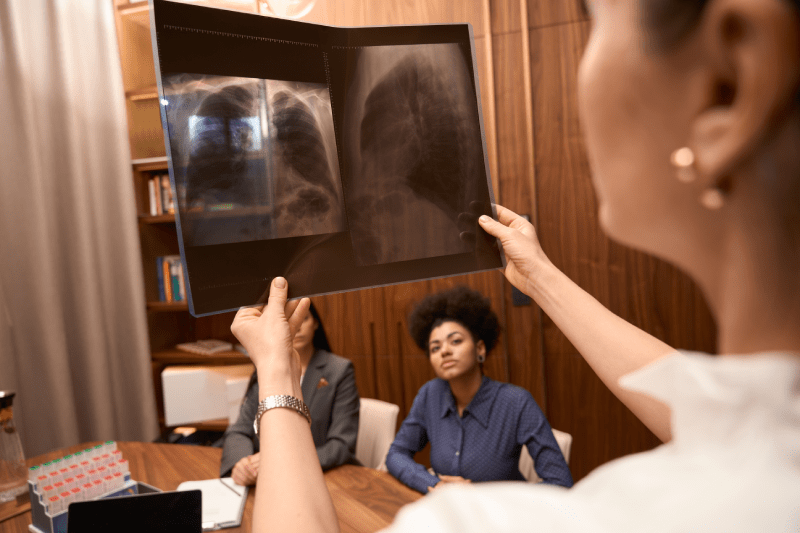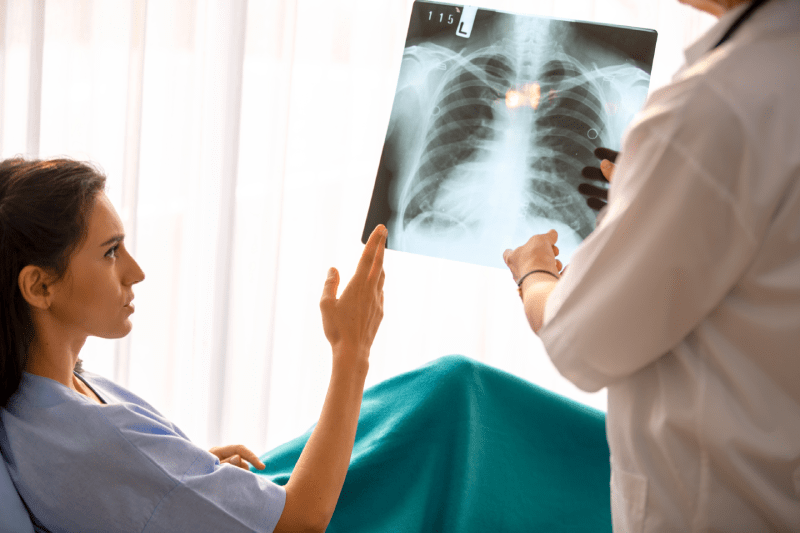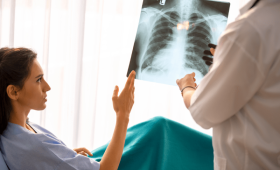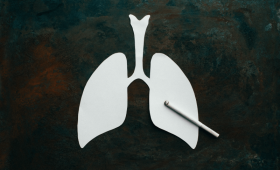Lung Cancer Survival Guide
A lung cancer diagnosis is a source of deep concern for patients and families, and the first question that comes to mind is often about survival time. However, oncology has made great progress in this area today. Especially immunotherapy and smart drugs have fundamentally changed treatment approaches and have extended the lifespan for many patients, making Stage 4 cancer a manageable chronic disease. Survival time largely depends on the cancer’s molecular structure and stage, so fast access to personalized treatment is vital. Here are the 35 most frequently asked questions about survival time in Lung Cancer.
What Is The Most Important Factor Determining Survival Time In Lung Cancer?
The most important factor determining survival time is the stage of the disease at the time of diagnosis. The size of the tumor, whether it has spread to nearby lymph nodes, and whether it has metastasized to distant organs (brain, bone, liver, etc.) fundamentally change the prognosis. The chance of cure is very high in cancers caught in the early stage (Stage 1) and completely removable by surgery. In contrast, in metastatic (Stage 4) cancers, treatment goals focus on extending life and preserving quality of life. Therefore, early detection screenings are vital, and centers in Turkey use advanced technologies in this area.
How Does Early Diagnosis Affect The Lung Cancer Prognosis?
Early diagnosis dramatically improves the lung cancer prognosis. When the disease is caught while still confined to the lung (Stage 1), complete recovery (cure) can be achieved in the vast majority of patients with surgical treatment. Five-year survival rates in early stages can range between 60% and 90%. In Stage 4 cancers diagnosed late, these rates are lower; this causes the treatment strategy to shift towards palliative care. Low-dose computed tomography (CT) screenings offer an opportunity for early diagnosis, especially for individuals in the risk group, fundamentally altering survival time.
What Are The Five-Year Survival Rates In Stage 1 Lung Cancer?
The five-year survival rates in Stage 1 lung cancer usually range between 60% and 90%, depending on the tumor’s substage (1A, 1B). These high rates are due to the cancer being localized at this stage and its ability to be completely removed by surgery (VATS/Robotic Surgery). Five-year survival indicates the percentage of patients who remain alive for at least five years and is accepted as a measure of success in oncology. For patients caught at this stage, quitting smoking and adopting a healthy lifestyle are key to making this high success permanent.
What Is The Average Survival Time In Stage 4 Lung Cancer?
The average survival time in Stage 4 lung cancer has significantly lengthened, ranging from a few months to several years with new treatments, depending on the response to treatment, tumor subtype, and genetic features. Especially if the tumor has a genetic mutation (EGFR, ALK, etc.) targetable by smart drugs or a high PD-L1 expression predicting a response to immunotherapy, the life expectancy increases manifold compared to classical chemotherapy. This indicates that even Stage 4 cancer has become a manageable chronic disease today.
Does The Type Of Lung Cancer (Small Cell/Non-Small Cell) Affect Survival Time?
Yes, the type of lung cancer (Small Cell/Non-Small Cell) has a major impact on survival time. Non-Small Cell Lung Cancer (NSCLC) progresses slower and offers a chance of cure with surgery in the early stage. Small Cell Lung Cancer (SCLC) is highly aggressive, spreads quickly, and generally responds well to treatment initially but has a high likelihood of recurrence. Therefore, long-term survival is possible with personalized treatments in NSCLC, whereas the prognosis in SCLC is usually more limited and requires urgent treatment.
How Much Can Smart Drug Treatments Prolong Survival Time?
Smart drug treatments (targeted therapies) can significantly prolong survival time, even providing remissions lasting for years, in lung cancer patients whose tumors carry the relevant genetic mutation (EGFR, ALK, etc.). Because these drugs directly block the growth pathways of cancer cells, they have fewer side effects compared to traditional chemotherapy and preserve the patients’ quality of life. The effectiveness of the drugs is continuously updated with new-generation medications in case cancer cells develop resistance over time.
Can Immunotherapy Provide A Permanent Response In Lung Cancer Treatment?
Immunotherapy has the potential to provide a permanent response in lung cancer treatment by activating the patient’s own immune system. Responses that are more prolonged and carry a lower risk of recurrence than traditional treatments are possible. Especially in patients with high PD-L1 expression, immunotherapy can create lasting immune memory, keeping the cancer controlled for many years. This is one of the greatest innovations that significantly increases life expectancy even for Stage 4 patients.

How Do Tumor Size And Lymph Node Involvement Affect Prognosis?
Tumor size (T) and lymph node involvement (N) are critical factors that directly and negatively affect the lung cancer prognosis. As tumor size increases or spread to lymph nodes (N1, N2, N3) increases, the stage of the disease rises, and the chance of cure decreases. Since lymph node involvement is an indicator of the cancer’s potential for systemic spread, additional treatments like chemotherapy and/or radiotherapy after surgery are usually required for patients in this condition.
How Do The Patient’s Smoking History And Quitting Affect Survival Time?
The patient’s smoking history not only increases the risk of cancer development but also negatively affects the treatment process and survival time. Quitting smoking is of vital importance from the moment treatment begins. Smoking reduces the effectiveness of chemotherapy and radiotherapy, exacerbates side effects, and increases the risk of recurrence. Scientific studies have proven that patients who quit smoking immediately at the start of treatment respond better to treatment and have longer survival times.
How Does The Location Of Metastases Affect The Prognosis In Lung Cancer?
The location of metastases significantly affects the prognosis in lung cancer. For example, the presence of only one organ and a small number of metastases (oligometastasis) has a better prognosis than widespread metastasis. Spread to the bones requires pain management, while spread to the brain requires emergency radiotherapy or surgical intervention and generally restricts the prognosis more. Treatment is personalized with local methods (SBRT) or systemic therapies according to the region of metastasis.
How Do Age And General Health Status Determine Treatment Options And Survival Time?
Age and general health status (performance status) are indispensable criteria that determine treatment options and consequently survival time. While chronological age is not an obstacle on its own, the risk of side effects from aggressive treatments like surgery or intense chemotherapy is higher in elderly patients or those with severe additional chronic diseases (heart failure, COPD). In this case, less intense, more tolerable treatments (immunotherapy only, low-dose chemotherapy) are preferred to maximize quality of life and survival time.
What Is The Importance Of The Speed Of Starting Treatment On Survival?
The speed of starting treatment is of critical importance for survival, especially in aggressive cancer types (like Small Cell). Since cancer is a rapidly progressing disease, it is essential that treatment is not delayed after diagnosis and molecular tests are completed. One of the biggest advantages of advanced oncology centers in Turkey is their ability to start treatment at international standards within a few weeks after diagnosis without long waiting lists. A fast start plays a key role in preventing the spread of the disease.
What Is The Chance For Patients With Initial Weight Loss And Poor Performance Status?
The prognosis for patients with initial weight loss (cachexia) and poor performance status (ability to perform daily activities) is lower than for patients whose factors are good. Weight loss reduces the body’s resistance to treatment and its ability to tolerate side effects. Therefore, stabilizing the patient’s general condition with nutritional support and palliative care before starting treatment is of great importance. Poor performance status may lead to the reduction or postponement of intensive treatment doses.
What Are The Five-Year Survival Rates In Lung Cancer In Percentages?
The general five-year survival rates for lung cancer, when all stages are evaluated together, usually range between 15% and 20%. However, this general rate varies greatly according to the stage of the disease. While it can reach 60-90% in Stage 1, this rate starts below 5% in Stage 4, but with new-generation smart drugs and immunotherapy, these rates are significantly increasing. These statistics represent an average value, and each patient’s individual situation may differ.
How Is Survival Time Affected If Resistance To Treatment Develops?
If resistance to treatment develops, survival time is affected depending on whether the patient switches quickly to new treatment options. Especially resistance developed by cancer cells against smart drug treatments (secondary mutations) can accelerate the progression of the disease. In this situation, the detection of new mutations with liquid biopsy and switching to second or third-generation drugs is vital. If an effective new treatment cannot be found, resistance development unfortunately restricts survival time.

Is The Treatment Approach Different In Case Of A Single Metastasis (Oligometastasis)?
Yes, the treatment approach in case of a single metastasis (oligometastasis) can be much more aggressive and different compared to widespread metastasis. In this case, local and ablative treatments such as surgical resection or SBRT (Stereotactic Body Radiotherapy) are applied to the metastasis site to try to completely eliminate this spread. This local treatment, combined with systemic therapies (immunotherapy/smart drugs), significantly increases the patient’s survival time and chance of cure compared to patients with widespread metastasis.
What Is The Importance Of Personalized Treatment (Molecular Analysis)?
The importance of personalized treatment (molecular analysis) is to ensure that the right drug is given to the right patient. Molecular tests performed, especially in NSCLC (EGFR, ALK, PD-L1), determine which smart drug or immunotherapy the patient will respond to. Planning the treatment not only according to the cancer type but also according to the cancer’s individual genetic signature maximizes treatment effectiveness, prevents unnecessary side effects, and significantly improves the patient’s response duration, thus improving survival expectations.
When Is The Risk Of Recurrence Highest After Lung Cancer Treatment?
The risk of recurrence after lung cancer treatment is generally highest within the first 2 years following the completion of treatment. This risk increases as the stage advances (especially Stage 2 and 3). Early recurrence indicates the aggressiveness of the remaining microscopic cancer cells. Therefore, patients are put on a strict follow-up program (physical examination, CT/PET-CT) at intervals of 3-6 months during the first two years. This meticulous follow-up ensures that a potential recurrence is detected and treated quickly in the early stage.
How Effective Is Radiotherapy Alone In Prolonging Survival Time?
Radiotherapy alone is very effective in prolonging survival time in early-stage patients not suitable for surgery (with SBRT) or in controlling advanced-stage metastases (brain, bone). SBRT provides local control rates similar to surgery, preventing the recurrence of the disease. Palliative radiotherapy, on the other hand, improves the quality of life by eliminating symptoms caused by the tumor (pain, bleeding) and indirectly affects survival time positively by preserving the patient’s general condition.
What Is The Success Of Combined Treatment In Stage 3 Lung Cancer?
The success of combined treatment in Stage 3 (locally advanced) lung cancer has significantly increased with the simultaneous application (concurrent) of chemotherapy and radiotherapy followed by immunotherapy consolidation. This triple approach ensures local control of the disease, while immunotherapy provides long-term systematic control, reducing the risk of recurrence. Thanks to these intensive and integrated treatment protocols, long-term survival rates have increased even in Stage 3 patients, who were previously considered to have a poor prognosis.
Which Patients Do New Generation Targeted Drugs Offer Hope To?
New generation targeted drugs are promising, especially in NSCLC patients who have developed resistance to first-generation smart drugs or have rare genetic mutations (such as RET, MET, HER2). These drugs target new resistance pathways that were bypassed or created by previous drugs, allowing the achievement of a response to treatment again. Thanks to fast molecular diagnosis methods, centers in Turkey quickly identify these patients, provide access to the latest drugs, and extend their survival times.
What Is The Role Of Supportive Care (Palliative) During The Treatment Process?
The role of supportive (palliative) care during the treatment process is critical for maximizing the patient’s quality of life and enabling them to cope with treatment side effects. This is not just end-of-life care. Palliative care manages symptoms such as pain, shortness of breath, nausea, and fatigue. It provides psychosocial and spiritual support, strengthening the patient’s compliance with treatment and keeping their morale high. This holistic approach indirectly increases treatment success by making the patient physically and emotionally stronger.
How Is It Possible To Preserve Quality Of Life While Living With Lung Cancer?
It is possible to preserve the quality of life while living with lung cancer by integrating active treatment with supportive care. Effective management of pain and other side effects by palliative care specialists, preserving muscle mass with nutritional counseling, and maintaining high energy levels with regular light exercise (walking) are essential. Furthermore, receiving psychological support and maintaining social activities play a key role in coping with the emotional burden of the disease, which significantly increases overall life satisfaction.
How Long Does The Immunotherapy Response Last And What Factors Influence This Duration?
The immunotherapy response in patients who respond to treatment can last for a long time, sometimes years. This prolonged response results from the immune system creating a lasting memory against cancer cells. The duration of the response depends on factors such as the tumor’s genetic structure, PD-L1 expression level, and the strength of the patient’s immune system. A long-lasting response significantly extends the patient’s survival time, reduces regular drug dependency, and allows them to maintain an active lifestyle.
How Do Persistent Side Effects After Treatment Affect Survival Time?
Persistent side effects seen after treatment (e.g., lung hardening after radiation pneumonitis or permanent neuropathy) directly affect the patient’s quality of life but generally do not directly shorten survival time. The important thing is the effective management of these side effects (e.g., difficulty breathing) with medications and rehabilitation programs. In cases where side effects are well managed, the patient can continue their active life; in cases where they are poorly managed, quality of life and treatment compliance drop, indirectly affecting survival.
What Is The Average Cure Rate For Patients Diagnosed With Lung Cancer?
The average cure rate (complete cure) for patients diagnosed with lung cancer varies significantly depending on the stage of the disease. For patients who undergo surgery in the early stage (Stage 1), the chance of complete cure is quite high. However, since most diagnoses in the general population are made at an advanced stage, the average cure rates are low when all stages are considered. Modern oncology, therefore, focuses on the goal of disease control and chronic management instead of cure, aiming to ensure patients live a long and high-quality life.
Does Surgical Intervention Have A Role In Advanced Lung Cancer?
The role of surgical intervention in Advanced Lung Cancer (Stage 4) is limited to alleviating symptoms (palliative) or locally controlling oligometastatic (few metastases) situations rather than providing a cure. For example, removing a tumor blocking the main airway or a single metastasis (e.g., in the brain) rapidly increases the patient’s quality of life and allows systemic treatments to be more effective. Such surgeries are performed by experienced surgeons only when the patient’s general condition allows.
What Is The Importance Of Regular Nutrition And Exercise During The Treatment Process?
The importance of regular nutrition and exercise during the treatment process is critical for treatment success. Regular nutrition ensures the patient preserves muscle mass, strengthens the immune system, and better tolerates the side effects of chemotherapy/radiotherapy. Regular low-intensity exercise (daily walking) reduces treatment-related fatigue and keeps the patient’s morale high. These two elements preserve the patient’s overall performance status, preventing treatment interruption.
Are There Environmental Factors Or Climate Changes That Affect Survival Time?
Although there are no climate changes that directly alter survival time, environmental factors (air pollution, radon gas, asbestos exposure) can indirectly affect the severity of the disease and the risk of recurrence. Chronic exposure to air pollution reduces the functional reserve of the lung and can increase the risk of side effects related to treatments like radiotherapy. Therefore, it is important for patients to pay attention to clean air conditions after treatment and avoid known environmental pollution for long-term health.

How Do Psychological Support And Will To Live Increase Survival Rates?
Psychological support and a strong will to live indirectly and positively affect survival rates. A strong psychological state increases the patient’s compliance and discipline with treatment, supports the immune system, and reduces stress levels. Support provided by psycho-oncology specialists helps patients cope with anxiety and depression. High morale and a strong motivation for life are important factors that increase the patient’s resistance to treatment, extending quality of life and survival time.
What Is The Success Of Second-Line Treatment In Relapsed Lung Cancer?
The success of second-line treatment in relapsed lung cancer depends on the timing, location of the relapse, and the new molecular features of the tumor. If the relapse is in the early stage and in a localized area after surgery, re-surgery or SBRT can be successful. In case of systemic relapse, the tumor’s new mutations are analyzed, and a switch is made to new-generation smart drugs or immunotherapy combinations. These personalized second-line treatments offer the chance to extend the patient’s life again.
How Does The Effect Of Different Histological Types (Adeno, Squamous) Affect Prognosis?
The effect of different histological types (Adenocarcinoma, Squamous Cell Carcinoma) on prognosis differs based on their molecular target potential. Adenocarcinoma (usually seen in non-smokers) generally carries treatable mutations like EGFR, ALK, and thus has the potential to achieve a longer and higher quality of life with smart drugs. Squamous Cell Carcinoma (more related to smoking) contains fewer targetable mutations, so it is generally directed towards immunotherapy/chemotherapy combinations, and its prognosis progresses differently.
Why Are Long-Term Follow-Up And Controls Vitally Important After Treatment?
Long-term follow-up and controls after treatment are vitally important for detecting a possible relapse, a second cancer, or late side effects of treatment at an early stage. Regular CT and PET-CT scans, along with blood tests, keep the risk of the disease returning under control. The first two years are especially critical. Compliance with this meticulous follow-up program is the most important step in securing the patient’s long-term survival by ensuring the early detection and quick treatment of any problem.
What Are The Advantages Of Advanced Lung Cancer Treatment In Turkey?
The advantages of advanced lung cancer treatment in Turkey are high-quality centers with international JCI accreditation, the possibility of quickly starting treatment without long waiting times, and access to immunotherapy/smart drugs at 50-70% more affordable costs compared to Western countries. Turkey also uses advanced technologies like minimal invasive surgery (VATS/Robotic), SBRT/VMAT, and offers comprehensive health tourism support such as accommodation, transfer, and medical interpretation for foreign patients, facilitating the treatment process.
What Is The Process To Start Treatment In Turkey Through Cure Holiday?
The process to start treatment in Turkey through Cure Holiday is simple and fast. The first step is to submit the patient’s all current medical reports (CT, PET-CT images, pathology, and molecular analysis results) to Cure Holiday. Cure Holiday forwards these reports to the most suitable oncology centers in Turkey, rapidly organizing a personalized treatment plan, cost quotation, and start date. Subsequently, it coordinates all travel, accommodation, and in-hospital interpretation services, allowing the patient to focus solely on their treatment.
The fight against lung cancer is a process that requires accurate diagnosis and personalized treatment strategies. Thanks to current oncology methods, it is possible to prolong survival time while preserving quality of life, regardless of the stage.
To quickly access current treatment options prepared by expert multidisciplinary teams in Turkey’s advanced oncology centers, manage this challenging process with a comfortable health tourism experience, and receive a personalized treatment plan, you can contact Cure Holiday.



